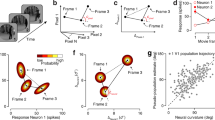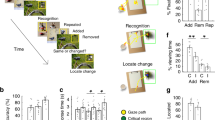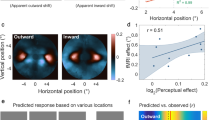Abstract
In generative models of brain function, internal representations are used to generate predictions of sensory input, yet little is known about how internal models influence sensory processing. Here we show that, with experience in a virtual environment, the activity of neurons in layer 2/3 of mouse primary visual cortex (V1) becomes increasingly informative of spatial location. We found that a subset of V1 neurons exhibited responses that were predictive of the upcoming visual stimulus in a spatially dependent manner and that the omission of an expected stimulus drove strong responses in V1. Stimulus-predictive responses also emerged in V1-projecting anterior cingulate cortex axons, suggesting that anterior cingulate cortex serves as a source of predictions of visual input to V1. These findings are consistent with the hypothesis that visual cortex forms an internal representation of the visual scene based on spatial location and compares this representation with feed-forward visual input.
This is a preview of subscription content, access via your institution
Access options
Subscribe to this journal
Receive 12 print issues and online access
$209.00 per year
only $17.42 per issue
Buy this article
- Purchase on Springer Link
- Instant access to full article PDF
Prices may be subject to local taxes which are calculated during checkout




Similar content being viewed by others
References
O'Keefe, J. & Dostrovsky, J. The hippocampus as a spatial map. Preliminary evidence from unit activity in the freely-moving rat. Brain Res. 34, 171–175 (1971).
Hafting, T., Fyhn, M., Molden, S., Moser, M.-B. & Moser, E.I. Microstructure of a spatial map in the entorhinal cortex. Nature 436, 801–806 (2005).
O'Keefe, J. & Conway, D.H. Hippocampal place units in the freely moving rat: why they fire where they fire. Exp. Brain Res. 31, 573–590 (1978).
Ji, D. & Wilson, M.A. Coordinated memory replay in the visual cortex and hippocampus during sleep. Nat. Neurosci. 10, 100–107 (2007).
Niell, C.M. & Stryker, M.P. Modulation of visual responses by behavioral state in mouse visual cortex. Neuron 65, 472–479 (2010).
Lee, H., Simpson, G.V., Logothetis, N.K. & Rainer, G. Phase locking of single neuron activity to theta oscillations during working memory in monkey extrastriate visual cortex. Neuron 45, 147–156 (2005).
Frankland, P.W., Bontempi, B., Talton, L.E., Kaczmarek, L. & Silva, A.J. The involvement of the anterior cingulate cortex in remote contextual fear memory. Science 304, 881–883 (2004).
Maviel, T., Durkin, T.P., Menzaghi, F. & Bontempi, B. Sites of neocortical reorganization critical for remote spatial memory. Science 305, 96–99 (2004).
Teixeira, C.M., Pomedli, S.R., Maei, H.R., Kee, N. & Frankland, P.W. Involvement of the anterior cingulate cortex in the expression of remote spatial memory. J. Neurosci. 26, 7555–7564 (2006).
Weible, A.P., Rowland, D.C., Monaghan, C.K., Wolfgang, N.T. & Kentros, C.G. Neural correlates of long-term object memory in the mouse anterior cingulate cortex. J. Neurosci. 32, 5598–5608 (2012).
Chen, T.-W. et al. Ultrasensitive fluorescent proteins for imaging neuronal activity. Nature 499, 295–300 (2013).
Hölscher, C., Schnee, A., Dahmen, H., Setia, L. & Mallot, H.A. Rats are able to navigate in virtual environments. J. Exp. Biol. 208, 561–569 (2005).
Dombeck, D.A., Khabbaz, A.N., Collman, F., Adelman, T.L. & Tank, D.W. Imaging large-scale neural activity with cellular resolution in awake, mobile mice. Neuron 56, 43–57 (2007).
Vogt, B.A. & Miller, M.W. Cortical connections between rat cingulate cortex and visual, motor, and postsubicular cortices. J. Comp. Neurol. 216, 192–210 (1983).
Miller, M.W. & Vogt, B.A. Direct connections of rat visual cortex with sensory, motor, and association cortices. J. Comp. Neurol. 226, 184–202 (1984).
Zhang, S. et al. Selective attention. Long-range and local circuits for top-down modulation of visual cortex processing. Science 345, 660–665 (2014).
Keller, G.B., Bonhoeffer, T. & Hübener, M. Sensorimotor mismatch signals in primary visual cortex of the behaving mouse. Neuron 74, 809–815 (2012).
Yaksi, E. & Friedrich, R.W. Reconstruction of firing rate changes across neuronal populations by temporally deconvolved Ca2+ imaging. Nat. Methods 3, 377–383 (2006).
Ziv, Y. et al. Long-term dynamics of CA1 hippocampal place codes. Nat. Neurosci. 16, 264–266 (2013).
Dombeck, D.A., Harvey, C.D., Tian, L., Looger, L.L. & Tank, D.W. Functional imaging of hippocampal place cells at cellular resolution during virtual navigation. Nat. Neurosci. 13, 1433–1440 (2010).
Rao, R.P.N. & Ballard, D.H. Predictive coding in the visual cortex: a functional interpretation of some extra-classical receptive-field effects. Nat. Neurosci. 2, 79–87 (1999).
Bastos, A.M. et al. Canonical microcircuits for predictive coding. Neuron 76, 695–711 (2012).
Eliades, S.J. & Wang, X. Neural substrates of vocalization feedback monitoring in primate auditory cortex. Nature 453, 1102–1106 (2008).
Keller, G.B. & Hahnloser, R.H.R. Neural processing of auditory feedback during vocal practice in a songbird. Nature 457, 187–190 (2009).
Saleem, A.B., Ayaz, A., Jeffery, K.J., Harris, K.D. & Carandini, M. Integration of visual motion and locomotion in mouse visual cortex. Nat. Neurosci. 16, 1864–1869 (2013).
Gavornik, J.P. & Bear, M.F. Learned spatiotemporal sequence recognition and prediction in primary visual cortex. Nat. Neurosci. 17, 732–737 (2014).
Xu, S., Jiang, W., Poo, M.-M. & Dan, Y. Activity recall in a visual cortical ensemble. Nat. Neurosci. 15, 449–455 (2012).
Shuler, M.G. & Bear, M.F. Reward timing in the primary visual cortex. Science 311, 1606–1609 (2006).
Poort, J. et al. Learning enhances sensory and multiple non-sensory representations in primary visual cortex. Neuron 86, 1478–1490 (2015).
Aghajan, Z.M. et al. Impaired spatial selectivity and intact phase precession in two-dimensional virtual reality. Nat. Neurosci. 18, 121–128 (2015).
Cho, J. & Sharp, P.E. Head direction, place, and movement correlates for cells in the rat retrosplenial cortex. Behav. Neurosci. 115, 3–25 (2001).
Alexander, A.S. & Nitz, D.A. Retrosplenial cortex maps the conjunction of internal and external spaces. Nat. Neurosci. 18, 1143–1151 (2015).
Weible, A.P., Rowland, D.C., Pang, R. & Kentros, C. Neural correlates of novel object and novel location recognition behavior in the mouse anterior cingulate cortex. J. Neurophysiol. 102, 2055–2068 (2009).
Leinweber, M. et al. Two-photon calcium imaging in mice navigating a virtual reality environment. J. Vis. Exp. 50885, e50885 (2014).
Dana, H. et al. Sensitive red protein calcium indicators for imaging neural activity. Elife http://dx.doi.org/10.7554/eLife.12727 (2016).
Mukamel, E.A., Nimmerjahn, A. & Schnitzer, M.J. Automated analysis of cellular signals from large-scale calcium imaging data. Neuron 63, 747–760 (2009).
Acknowledgements
We thank T. Mrsic-Flogel, E. Feinberg and A. Lüthi for discussion of and comments on earlier versions of this manuscript. We thank D. Gerosa-Erni for production of the AAV vectors, B. Wang for help with the construction of the microscope and virtual reality setup, and the members of the Keller laboratory for discussion and support. This work was supported by the Swiss National Science Foundation, the Novartis Research Foundation and the Human Frontier Science Program, and by a PhD fellowship from the Boehringer Ingelheim Fonds (A.F.).
Author information
Authors and Affiliations
Contributions
A.F., D.M. and H.K.O. performed the V1 experiments. D.M., A.F. and A.V.P. performed the CA1 experiments. M.L. performed the ACC experiments. A.F. analyzed the V1 data. A.F. and A.V.P. analyzed the CA1 data. A.F. and M.L. analyzed the ACC data. A.F., D.M., H.K.O. and G.B.K. wrote the manuscript.
Corresponding author
Ethics declarations
Competing interests
The authors declare no competing financial interests.
Integrated supplementary information
Supplementary Figure 1 Number and timing of virtual-corridor traversals.
(a), Number of traversals per condition for each animal. Note recording times were shorter for condition 3 and 5.
(b), Histogram of traversal times for all conditions.
Supplementary Figure 2 Stability of imaging of CA1 pyramidal neurons and ACC axons in V1.
(a), Example CA1 neurons recorded in the 5 different conditions.
(b), Example imaging regions for the ACC axons in V1. Note that due to the high density of axons and the low baseline fluorescence, alignment of the imaging regions for the ACC experiments was performed on blood vessel patterns and not on the axons themselves.
Supplementary Figure 3 The increase in classification accuracy of grating position in V1 cannot be explained by running speed or GCaMP dynamics.
(a), Confusion matrices as in Fig. 1e,h for pre- and post-anesthesia in V1 (left) and CA1 (right). In this and subsequent panels, Ane-pre: pre-experience anesthesia; Ane-post: post-experience anesthesia.
(b), Accuracy of the classifier predicting the animal’s location in the tunnel based on either neural activity (black line) or running speed (gray line) for conditions 1 through 4. Chance level of 20% (dashed line) is given by the 5 possible grating locations in the tunnel. Error bars: s.e.m.
(c), Classifier accuracy when trained on neural activity during fast (slow) traversals and tested on slow (fast) traversals. Error bars: s.e.m.
(d), Example of a raw activity trace in time (black), and the same trace deconvolved using an exponential deconvolution kernel with a time constant of 0.5 s (magenta).
(e), Classifier performance using raw and deconvolved traces. The similar performance suggests that down-sweeps in calcium signals are not the main predictors of spatial location in population activity. Error bars: s.e.m.
Supplementary Figure 4 Orientation-selective neurons in V1 (or CA1) become more (or less) selective with experience.
(a), Histogram of the selectivity index (SI) of all neurons averaged across conditions. Black bars: neurons with a SI ≥ 0.5 (≤ -0.5) were considered to be selective for A (B).
(b), Average responses of an example neuron to A (blue lines) and B (red lines) across presentations. Note the increase in selectivity between conditions 1 and 4, as well as between pre- and post-experience anesthesia. Gray shading indicates time window used to calculate SI. Blue and red shading indicate s.e.m.
(c), Average SI per condition for V1 as in a, showing the selectivity indices for each cell included (gray circles). Mean ± s.e.m. across animals. **: p = 0.0047, n.s.: p = 0.125, Wilcoxon Rank Sum test.
(d), As in c, but for CA1. *: p = 0.009; n.s.: p = 1, Wilcoxon Rank Sum test.
(e), Average activity of the same neurons (V1: black; CA1: green) shown in c per condition does not increase with time. Mean ± s.e.m. Conditions 1-4: V1: p = 0.093,: CA1: p = 0.12 (conditions 1-4). Pre- and post-anesthesia: V1: p = 1.5e-5; CA1: p = 1, Wilcoxon Rank Sum test.
(f), Average trial-to-trial stereotypy of activity increased with experience. Shown is the mean correlation coefficient r of activity traces of neurons shown in c and d in different traversals with the same and across different conditions. Mean ± s.e.m. (Note, for this analysis traversals were subsampled to match stereotypy of running speed across conditions). Conditions 1-4: V1: p = 0.00085; CA1: p = 0.44. Pre- and post-anesthesia: V1: p = 2.5e-8; CA1: p = 1, Wilcoxon Rank Sum test.
Supplementary Figure 5 Landmark responses in CA1 neurons.
(a), As in Fig. 1g, but for landmark responsive CA1 neurons. Note that neurons that respond to one landmark also exhibited responses to all other landmarks. Traces in the top panel are colored to indicate the neurons chosen from the matrix in the bottom panel.
(b), Schematic representation of the four-layer imaging in CA1. Field of view was approximately 250 µm by 250 µm and the spacing between the layers approximately 15 µm.
(c), Schematic representation of the position neurons in CA1 that responded to landmarks (blue), gratings (red), or were unresponsive (gray) for all five animals and conditions separately. Note, that there is no clear arrangement of neurons that respond to landmarks or gratings.
Supplementary Figure 6 Stability of grating responses between conditions is higher in V1 than in CA1.
(a), Normalized activity of grating selective CA1 neurons (SI ≥ 0.1) sorted by position of peak response in the tunnel. Selection of grating responsive neurons and sorting was done on condition 1 for the first row of plots. Data are shown for the same neurons using the same sorting for condition 2 through 5 in the remaining plots of the first row. Similarly for the remaining rows of plots.
(b), As in a, but for V1 data.
(c), Quantification of stability of responses in V1 and CA1. Shown is the fraction of neurons plotted in a and b that peak within 5% of tunnel length (or one texture length) between the conditions indicated.
Supplementary Figure 7 Dynamics of predictive and visual responses in V1, CA1 and ACC.
(a), Mean grating response of predictive neurons shown in Fig. 2b during pre- and post-experience anesthesia conditions.
(b), Histogram of selectivity of predictive (blue) and visual (red) neurons in V1 (left) and ACC axons in V1 (right). Mean selectivity index (SI) was similar for all four populations (V1 predictive: SI = 0.79 ± 0.04, V1 visual 0.82 ± 0.03, ACC predictive: 0.84 ± 0.008, ACC visual: 0.79 ± 0.004). Colored circles indicate mean SI, horizontal bars indicate s.e.m.
(c), Mean grating-triggered responses of the 20% of neurons (n = 229) with the highest response to grating B4. Gray shading marks time window used to quantify responses. Colors and shading as in Fig. 3e.
(d), Mean activity of predictive neurons plotted against mean activity of visual neurons for each presentation of gratings A3 and B4 in condition 4.
(e), Grating responses in condition 1 (orange) and condition 4 (blue) for grating-selective neurons (SI>0.1) for CA1 neurons, ACC axons, and V1 neurons. Note, grating related responses in CA1 decrease with experience, and anticipatory responses emerge in ACC and V1 data.
Supplementary Figure 8 Responses to grating omission are present in most animals and do not reflect sensorimotor mismatch.
(a), Population mean response to grating omission for each animal (dashed black lines, n=6). Shading indicates s.e.m.
(b), Responses of omission selective neurons to omission events and onsets of gray areas in the tunnel locations that are always encountered as gray. Shading indicates s.e.m.
(c), Average ACC axon population response (8599 axons) to the grating omission. Shading indicates s.e.m.
Supplementary Figure 9 Body weight trajectories.
Body weight in percent of starting weight for all animals used in V1 and CA1 experiments as a function of time since start of water restriction. Dashed line indicates the 80% threshold under which water restriction is halted.
Supplementary information
Supplementary Text and Figures
Supplementary Figures 1–9 (PDF 1975 kb)
Example video of naive mouse traversing the virtual corridor.
The video shows a mouse traversing the virtual corridor in a normal traversal (no grating omission) and a traversal where the final grating is omitted. (MP4 29657 kb)
Two-photon calcium imaging in CA1.
This video shows part of an imaging stack (sped approx. 20x) acquired from the CA1 principal cell layer as a mouse traversed the linear corridor. The green bar on the right indicates the mouse's running speed. (MP4 13679 kb)
Two-photon calcium imaging in ACC axons in V1.
This video shows part of an imaging stack (sped approx. 20x) acquired from ACC axons in V1 as the mouse traversed the linear corridor. The green bar on the right indicates running speed. (MP4 7906 kb)
Example omission response in V1.
This video shows neuronal activity from two consecutive traversals, a normal traversal (no grating omission at time 0) followed by a traversal where the final grating was omitted (at time 0). The inset shows the side view of the virtual corridor at the mouse's current position, and flashes at the onset of the B5 grating or the grating omission. (MP4 8378 kb)
Rights and permissions
About this article
Cite this article
Fiser, A., Mahringer, D., Oyibo, H. et al. Experience-dependent spatial expectations in mouse visual cortex. Nat Neurosci 19, 1658–1664 (2016). https://doi.org/10.1038/nn.4385
Received:
Accepted:
Published:
Issue Date:
DOI: https://doi.org/10.1038/nn.4385
This article is cited by
-
Behavior-relevant top-down cross-modal predictions in mouse neocortex
Nature Neuroscience (2024)
-
Interactions between rodent visual and spatial systems during navigation
Nature Reviews Neuroscience (2023)
-
Repeated passive visual experience modulates spontaneous and non-familiar stimuli-evoked neural activity
Scientific Reports (2023)
-
Pinging the brain to reveal the hidden attentional priority map using encephalography
Nature Communications (2023)
-
Serial dependencies between locomotion and visual space
Scientific Reports (2023)



